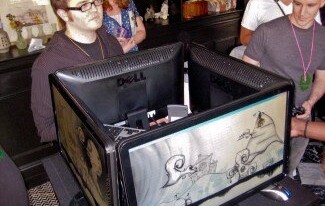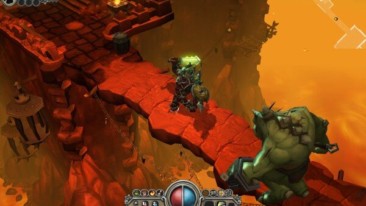 You have seen tile games before – a board of pieces with one open space into which you can slide any of the existing tiles in order to solve a puzzle. So why would the world ever need another one? Well, you could say the same thing for the automobile, except that there are always new and improved designs to make the experience that much more enjoyable.
You have seen tile games before – a board of pieces with one open space into which you can slide any of the existing tiles in order to solve a puzzle. So why would the world ever need another one? Well, you could say the same thing for the automobile, except that there are always new and improved designs to make the experience that much more enjoyable.
Cogs brings the best in both tile based puzzles and design together, appropriately drawing from the Steampunk aesthetic (although the creator admits this association was recognized after the fact) and pairing it smooth, increasingly challenging gameplay.
IGR was fortunate enough to interview Rob Jagnow, head of Lazy 8 Studios, and ask him about the game’s development.
IndieGameReviewer.com: Give us a brief timeline of the events that led to you not only creating but becoming capable of creating as complex a game as is Cogs.
Rob Jagnow: Cogs has been a part-time project for a long time. From conception to completion, it took nearly five years to finish, during which time I also graduated from grad school, traveled around the world, worked for a studio in Boston and finally ended up in San Francisco with enough time to finish the game. I have a Ph.D. in Computer Science with a focus in graphics, which you might think would make me qualified for game design, but it’s really my time at Demiurge Studios in Boston that taught me how to make a great game.
IGR: At the IndieCade microtalk you spoke briefly about wearing many hats. Tell us a little about the process for getting Cogs to market and what you have learned since it went up for sale to the public.
RJ: Most indie developers understand that you have to wear a lot of hats to make a game. If you’re working alone or with a small team, you need to be a programmer, producer, concept artist, UI designer, and level designer. We all have this idea in our head that we’ll release the game, kick back and let the cash roll in. But the reality is that when the game is done, the work is just getting started. If you want to find a distributor and sell enough copies to finance the next project, then you also need to take on the jobs of reading legal contracts, writing press releases, expanding your list of online distributors and promoting the game.

IGR: Once I had a writer who read a manuscript I had written point out how Steampunk my environment was. I only realized this after the fact. I believe the surge of interest in Steampunk comes from a nostalgia for times less virtual, a love for tactile tinkering. Talk about your interest in Steampunk.
RJ: Honestly, I had never heard of “steampunk” before I started work on Cogs. But when I started searching the Web for concept art that matched the polished mechanical universe that I was trying to create, I kept seeing that word. Brendan Mauro, who did all the artwork for Cogs, had a more refined artistic background and already had some experience in steampunk design. He was an ideal fit for the project and turned Cogs into something far more beautiful than it ever appeared in my imagination.
The one big design principle that I laid out from the very beginning was that the game must be 100% mechanical: No HUD overlay, no harsh transitions, nothing appearing or disappearing. We stuck to this rule all the way through to the end credits, which are built in to the final puzzle. When you turn the crank on the box, the credits roll by on a long piece of parchment. The result is a truly immersive environment where you really feel like you’re interacting with a massive steampunk contraption.

IGR: How do you create and implement puzzles as complex as the ones in Cogs? It is one thing to solve them, but I imagine exponentially more complex to create them!
RJ: Whenever I needed inspiration, I would go for a jog and let various ideas stew in my brain until a puzzle finally took shape. As it turns out, designing challenging puzzles isn’t actually that difficult. The hard part is creating simpler introductory levels that still have a lot of variety. I actually designed about 60 puzzles total but threw out the ones that felt repetitive or weren’t as much fun. That left us with 50 puzzles in the final release. Cogs was released with mod support from the very beginning, so I’m happy to see some modders releasing a few free puzzles online for those who have finished the game and are looking for more.
IGR: What’s next for Lazy 8?
RJ: Just about everyone who plays Cogs for the first time has the same reaction: “Wow, I’d love to have this on my iPhone.” So that port is in the works. After that, I have a few ideas for other casual games, but our next project, which is still a secret, will be something totally different. The one thing you can expect is that Lazy 8 Studios will always aim for same level of care and polish that we poured into Cogs.
Download Cogs now at Direct2Drive



